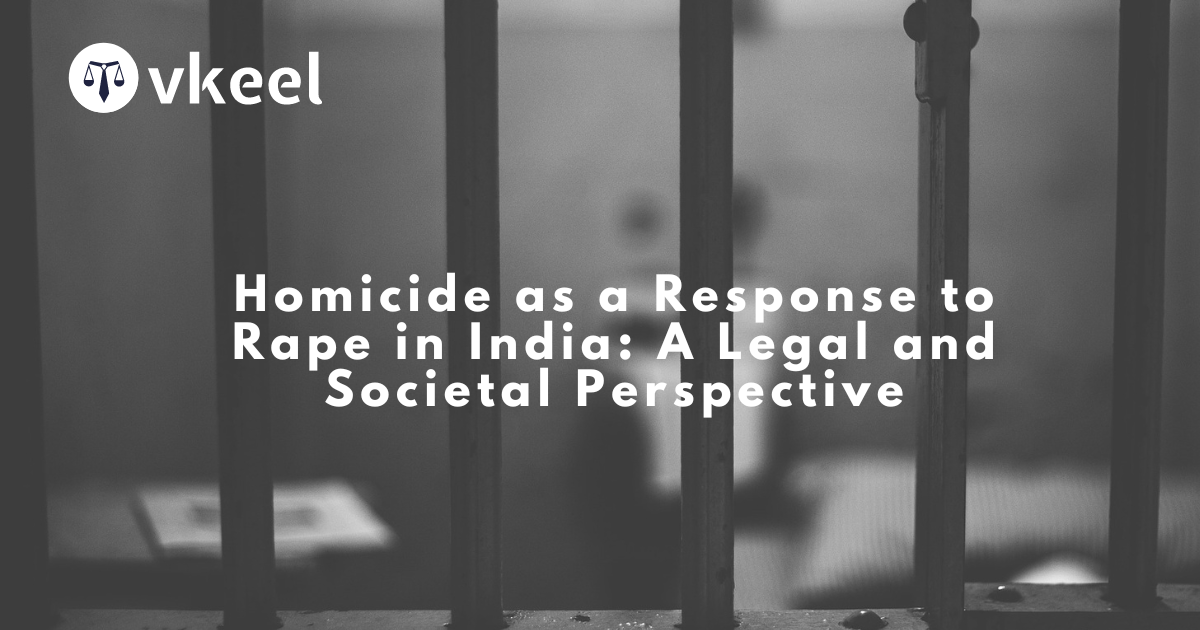Homicide as a Response to Rape in India: A Legal and Societal Perspective
By Himanshu Kumar
Table of Contents
Introduction
Rape is a grievous offense that not only shatters the lives of victims but also disrupts the social fabric of society. In India, where honor and reputation often dictate social standing, rape is seen not just as a crime against an individual but as an assault on family and community honor. This cultural perception, combined with societal stigmatization, often leads to extreme responses, including homicide. The legal implications of homicide as a response to rape are complex and nuanced, requiring an exploration of both criminal law and the societal context in which such acts occur.
The primary reason for homicide in India that often leads to rape is deeply rooted in societal notions of power, control, and gender inequality. In many instances, rape is not merely a crime of passion or desire but a deliberate act of asserting dominance and subjugating the victim. This behavior is often fueled by entrenched patriarchal norms that view women as property or symbols of honor, rather than as individuals with agency. When a woman resists or when her autonomy challenges this traditional power structure, it can provoke violent retaliation, including homicide, as a means to reassert control.
Furthermore, the intersection of caste and class disparities also plays a significant role in these crimes. In rural areas, especially, where the social hierarchy is rigidly enforced, women from lower castes or economically disadvantaged backgrounds are particularly vulnerable to sexual violence as a tool of oppression. When the perpetrators are from a higher caste or social standing, the crime is often perpetrated with the intent of reinforcing social dominance. In such cases, the homicide may occur either during the act of rape or as a premeditated consequence to silence the victim and prevent her from seeking justice, thus perpetuating a cycle of violence and impunity.
Legal Framework: Understanding Rape and Homicide in India
The Indian Penal Code (IPC), 1860, provides the legal framework for addressing rape and homicide. Rape, defined under Section 375 of the IPC, was significantly amended by the Criminal Law (Amendment) Act, 2013, following the Nirbhaya case. The amendment expanded the definition of rape, increased the severity of punishments, and introduced new provisions to protect victims.
Homicide, on the other hand, is addressed under Sections 299 and 300 of the IPC, which define culpable homicide and murder, respectively. Section 299 defines culpable homicide as the act of causing death with the intention of causing death, or with the knowledge that the act is likely to cause death. Section 300 further distinguishes murder from culpable homicide by considering the degree of intention and premeditation involved.
When homicide occurs as a response to rape, the legal questions often revolve around the intent and provocation behind the act. The perpetrator’s state of mind, the circumstances leading to the homicide, and the relationship between the victim and the offender are all critical factors in determining the legal outcome.
Case Laws and Judicial Interpretations
The Indian judiciary has encountered several cases where homicide was committed in response to rape. These cases highlight the complexity of adjudicating such matters, where emotions run high, and societal values clash with legal principles.
- Nirbhaya Case (Mukesh & Anr vs State for NCT of Delhi & Ors, 2017) The Nirbhaya case is one of the most significant legal battles in India’s history, where the brutal gang rape of a young woman in Delhi led to widespread outrage and demands for stricter laws. Although this case did not directly involve homicide as a response to rape, the societal reaction, including calls for the death penalty for the rapists, reflects the intense emotions and the desire for retributive justice that often accompany such crimes. The case led to the enactment of the Criminal Law (Amendment) Act, 2013, which introduced the death penalty for repeat offenders in rape cases and expanded the definition of rape. This amendment also provided for life imprisonment and introduced the concept of “aggravated rape,” which includes situations where the victim dies or is reduced to a vegetative state.
- State of Uttar Pradesh vs Gajendra Singh, 1984 In this case, the accused killed a man who had allegedly raped his sister. The court, while acknowledging the intense provocation, held that the homicide was committed under a “grave and sudden provocation” and reduced the charge from murder to culpable homicide not amounting to murder under Exception 1 to Section 300 of the IPC. The court’s decision reflects the judiciary’s recognition of the emotional turmoil that rape victims and their families undergo. However, it also underscores the importance of adhering to the rule of law, where even heinous crimes like rape do not justify taking the law into one’s own hands.
- Surendra Koli vs State of Uttar Pradesh, 2011 (Nithari Case) The Nithari case involved the discovery of multiple murders and sexual assaults in a village in Uttar Pradesh. Surendra Koli, the prime accused, was convicted of rape and murder of several children. The gruesome nature of the crimes led to widespread anger, and Koli was sentenced to death. Although this case does not involve homicide as a direct response to rape, it highlights the judicial system’s approach to handling crimes that provoke extreme societal reactions. The case demonstrates the balance that the judiciary must strike between delivering justice and preventing vigilante responses.
Legal Provisions and Amendments: A Balancing Act
India’s legal system provides certain defenses and exceptions that can be invoked in cases where homicide is committed in response to rape. These include:
- Grave and Sudden Provocation (Exception 1 to Section 300 IPC) The defense of grave and sudden provocation can be invoked to reduce a charge of murder to culpable homicide not amounting to murder. This defense acknowledges that a person who is provoked to such an extent that they lose self-control should not be held to the same standard of culpability as someone who commits premeditated murder. However, the application of this defense is not straightforward. Courts must carefully assess whether the provocation was indeed grave and sudden, and whether the response was proportional. In cases of rape, where the victim’s family members commit homicide, the judiciary has occasionally accepted this defense, though it remains a contentious issue.
- Right of Private Defense (Section 96-106 IPC) The right of private defense allows an individual to protect themselves or others from imminent harm. Under Section 100 of the IPC, the right extends to causing death if the assault is of such a nature that it may reasonably cause apprehension of death or grievous hurt. In cases of rape, this right could be invoked if the victim or their family members kill the rapist in the act of defending the victim. However, the invocation of this right requires that the threat be immediate and the response proportionate.
- Criminal Law (Amendment) Act, 2013 The 2013 amendment to the IPC introduced several changes that indirectly influence cases of homicide committed in response to rape. The amendment expanded the scope of self-defense, enhanced the punishments for rape, and introduced new offenses like stalking and voyeurism. These changes reflect the legislature’s intent to provide better protection for women and to deter sexual violence. However, the amendment also raises questions about the appropriate response to rape. While it strengthens the legal framework for prosecuting rapists, it does not address the societal factors that drive victims or their families to commit homicide in response to rape. The amendment’s focus on punitive measures does not necessarily translate into greater justice for those who take the law into their own hands.
Societal and Psychological Factors
Homicide as a response to rape cannot be understood solely through the lens of legal provisions. Societal and psychological factors play a significant role in shaping the responses of victims and their families.
- Honor and Stigmatization In many parts of India, rape is perceived as an attack on a family’s honor. Victims are often stigmatized, blamed, and ostracized by society. This stigmatization can lead to feelings of shame, guilt, and anger, driving victims or their family members to commit extreme acts, including homicide. The concept of honor is deeply ingrained in Indian society, particularly in rural areas. When a family’s honor is perceived to be at stake, the pressure to restore it can be overwhelming. In such cases, homicide may be seen as a way to avenge the dishonor and to assert the family’s social standing.
- Psychological Trauma The psychological trauma of rape can lead to severe emotional distress for both the victim and their family. This trauma can manifest in various ways, including anger, depression, and a desire for revenge. In some cases, this emotional turmoil can culminate in homicidal acts, particularly when the legal system is perceived as slow or ineffective. Psychological studies have shown that victims of rape and their families often experience intense feelings of helplessness and powerlessness. These feelings can be exacerbated by societal attitudes that blame the victim or minimize the severity of the crime. In such a context, homicide may be seen as a means of regaining control and asserting agency.
- Societal Responses and Vigilantism In some cases, communities may condone or even support homicide as a response to rape, particularly in areas where law enforcement is weak or corrupt. Vigilante justice, where community members take the law into their own hands, is not uncommon in such settings. Vigilantism reflects a broader societal failure to provide adequate protection and justice for rape victims. When the legal system is perceived as failing to deliver justice, individuals and communities may resort to extrajudicial measures, including homicide, to address grievances.
Conclusion
Homicide as a response to rape in India presents a complex legal and societal challenge. While the Indian legal system provides avenues for addressing both rape and homicide, the societal context in which these crimes occur often complicates the legal response. The tension between upholding the rule of law and recognizing the emotional and psychological toll of rape on victims and their families is a delicate balance that the judiciary must navigate.
The cases and legal provisions discussed above highlight the need for a nuanced approach to adjudicating cases where homicide is committed in response to rape. While the defense of grave and sudden provocation or the right of private defense may be applicable in certain cases, the broader societal factors driving such responses must also be addressed.
Ultimately, the goal should be to create a legal and societal environment where rape victims and their families receive the support and justice they deserve, without resorting to extrajudicial measures. This requires not only a robust legal framework but also a societal shift in attitudes towards rape and honor. Only then can India move towards a more just and equitable society, where the rule of law prevails, and the dignity of all individuals is upheld.
Disclaimer:
The information provided in the article is for general informational purposes only, and is not intended to constitute legal advice or to be relied upon as a substitute for legal advice. Furthermore, any information contained in the article is not guaranteed to be current, complete or accurate. If you require legal advice or representation, you should contact an attorney or law firm directly. We are not responsible for any damages resulting from any reliance on the content of this website.






